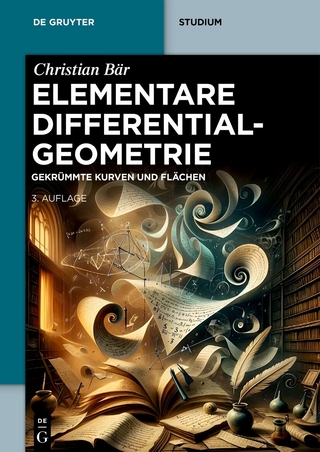
Discrete Differential Geometry
Integrable Structure
Seiten
2009
American Mathematical Society (Verlag)
978-0-8218-4700-8 (ISBN)
American Mathematical Society (Verlag)
978-0-8218-4700-8 (ISBN)
- Titel erscheint in neuer Auflage
- Artikel merken
For a given smooth geometry one can suggest many different discretizations. Which one is the best?This book answers this question by providing fundamental discretization principles and applying them to numerous problems. It turns out that intelligent theoretical discretizations are distinguished also by their good performance in applications.
An emerging field of discrete differential geometry aims at the development of discrete equivalents of notions and methods of classical differential geometry. The latter appears as a limit of a refinement of the discretization. Current interest in discrete differential geometry derives not only from its importance in pure mathematics but also from its applications in computer graphics, theoretical physics, architecture, and numerics. Rather unexpectedly, the very basic structures of discrete differential geometry turn out to be related to the theory of integrable systems. One of the main goals of this book is to reveal this integrable structure of discrete differential geometry. For a given smooth geometry one can suggest many different discretizations. Which one is the best?This book answers this question by providing fundamental discretization principles and applying them to numerous concrete problems. It turns out that intelligent theoretical discretizations are distinguished also by their good performance in applications. The intended audience of this book is threefold. It is a textbook on discrete differential geometry and integrable systems suitable for a one semester graduate course. On the other hand, it is addressed to specialists in geometry and mathematical physics. It reflects the recent progress in discrete differential geometry and contains many original results.The third group of readers at which this book is targeted is formed by specialists in geometry processing, computer graphics, architectural design, numerical simulations, and animation. They may find here answers to the question 'How do we discretize differential geometry?' arising in their specific field. Prerequisites for reading this book include standard undergraduate background (calculus and linear algebra). No knowledge of differential geometry is expected, although some familiarity with curves and surfaces can be helpful.
An emerging field of discrete differential geometry aims at the development of discrete equivalents of notions and methods of classical differential geometry. The latter appears as a limit of a refinement of the discretization. Current interest in discrete differential geometry derives not only from its importance in pure mathematics but also from its applications in computer graphics, theoretical physics, architecture, and numerics. Rather unexpectedly, the very basic structures of discrete differential geometry turn out to be related to the theory of integrable systems. One of the main goals of this book is to reveal this integrable structure of discrete differential geometry. For a given smooth geometry one can suggest many different discretizations. Which one is the best?This book answers this question by providing fundamental discretization principles and applying them to numerous concrete problems. It turns out that intelligent theoretical discretizations are distinguished also by their good performance in applications. The intended audience of this book is threefold. It is a textbook on discrete differential geometry and integrable systems suitable for a one semester graduate course. On the other hand, it is addressed to specialists in geometry and mathematical physics. It reflects the recent progress in discrete differential geometry and contains many original results.The third group of readers at which this book is targeted is formed by specialists in geometry processing, computer graphics, architectural design, numerical simulations, and animation. They may find here answers to the question 'How do we discretize differential geometry?' arising in their specific field. Prerequisites for reading this book include standard undergraduate background (calculus and linear algebra). No knowledge of differential geometry is expected, although some familiarity with curves and surfaces can be helpful.
Classical differential geometry Discretization principles. Multidimensional nets Discretization principles. Nets in quadrics Special classes of discrete surfaces Approximation Consistency as integrability Discrete complex analysis. Linear theory Discrete complex analysis. Integrable circle patterns Foundations Solutions of selected exercises Bibliography Notations Index.
| Erscheint lt. Verlag | 30.1.2009 |
|---|---|
| Reihe/Serie | Graduate Studies in Mathematics |
| Zusatzinfo | Illustrations |
| Verlagsort | Providence |
| Sprache | englisch |
| Gewicht | 921 g |
| Themenwelt | Mathematik / Informatik ► Mathematik ► Geometrie / Topologie |
| ISBN-10 | 0-8218-4700-7 / 0821847007 |
| ISBN-13 | 978-0-8218-4700-8 / 9780821847008 |
| Zustand | Neuware |
| Haben Sie eine Frage zum Produkt? |
Mehr entdecken
aus dem Bereich
aus dem Bereich
Gekrümmte Kurven und Flächen
Buch | Softcover (2024)
De Gruyter (Verlag)
54,95 €
Nielsen Methods, Covering Spaces, and Hyperbolic Groups
Buch | Softcover (2024)
De Gruyter (Verlag)
109,95 €


